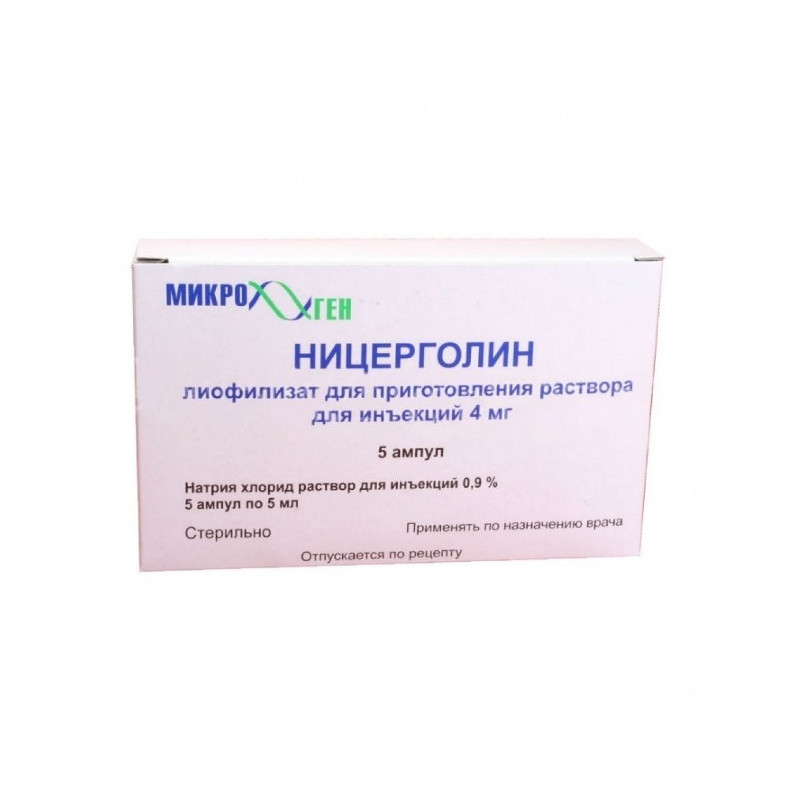



 All payments are encrypted via SSL
All payments are encrypted via SSL
 Full Refund if you haven't received your order
Full Refund if you haven't received your order
Acute and chronic disorders of cerebral circulation, especially in the early stages (vascular metabolic disorders; cerebral atherosclerosis; in the aftermath of thrombosis, occlusion of cerebral vessels); prevention of migraine and vascular headache; supportive treatment for high blood pressure.
pharmachologic effect
Chemical structure of Nicergoline is an analogue of ergot alkaloids, containing, in addition to the ergolin core, the bromo-substituted nicotinic acid residue.
By analogy with the dihydrogenated derivatives of ergot alkaloids, nicergoline has an a-adrenergic blocking effect. In addition, it exhibits antispasmodic activity, especially in relation to the cerebral and peripheral vessels, which, to some extent, may be due to the presence of a nicotinic acid residue in its molecule. The drug reduces the resistance of cerebral vessels and lungs, increases blood flow, especially in patients with functional arteriopathy, improves the condition of patients with impaired brain function due to vascular insufficiency, is effective in disorders of the central and peripheral circulation, has a positive effect on the condition of patients during the recovery period after ischemia brain.Nicergolin improves hemodynamics and metabolism both in the brain and in peripheral tissues. The use of nicergolin in patients with neurosurgical pathology helps to improve the vegetative regulation of cerebral blood flow and the bioelectric activity of the brain, affecting mainly the limbic structures and the hypothalamus. The drug has an antiplatelet effect and has a positive hemorheological effect; improves neuropsychiatric status in people with senile dementia.
After oral administration, nicergoline is rapidly and almost completely absorbed. The rate and amount of absorption of nicergoline does not depend on food intake. More than 90% of nicergoline binds to plasma proteins, while showing a more pronounced affinity for the acidic α-glycoprotein than for albumin. Nicergoline is metabolized in the liver to form two major metabolites, MMDL (1,6-dimethyl-8b-hydroxymethyl-10a-methoxy-ergoline) and MDL (6-methyl-8b-hydroxymethyl-10a-methoxy-ergoline). MMDL is a compound that is formed by ether hydrolysis. In the process of biotransformation, MDL is formed due to the cleavage of the methyl group in position 1 of the ergoline structure. The process of demethylation occurs when the catalytic action of the isoenzyme CYP2D6. Excreted mainly with urine; a small amount of nicergoline and / or its metabolites is excreted in the bile.
Dosage and administration
Intramuscularly, 2-4 mg are distributed into 1-2 injections every day. Intravenous 4-8 mg in 100 ml of isotonic sodium chloride solution. Methods of administration, dose and time of treatment depend on the individual indicators of the patient. Intraarterially, 4 mg in 10 ml of isotonic sodium chloride solution for 2 minutes. The solution, ready for injection, can be stored at room temperature for up to 48 hours.
Contraindications
Hyper hypersensitivity, recent myocardial infarction, acute bleeding, severe bradycardia, orthostatic hypotension.C caution. Hyperuricemia or gout in history and / or in combination with drugs that violate the metabolism and excretion of uric acid, pregnancy, lactation.
Side effects
dyspepsia (nausea, vomiting, diarrhea, abdominal pain); fever, sleep disturbances (drowsiness or insomnia), not often - a pronounced decrease in blood pressure; dizziness, skin rash, allergic reactions, hyperuricemia (severity does not depend on the dose and duration of therapy). Overdose. Symptoms: transient pronounced decrease in blood pressure. Treatment: put the patient in a horizontal position, if necessary - symatomimetiki under the control of blood pressure.
Use with other drugs
Enhances the effects of antihypertensive drugs. The possibility of interaction of nicergolin with drugs metabolized by cytochrome CYP2D6 cannot be ruled out.
Release form
Powder in vials of 4 mg and 5 ml ampoules with a solvent.
Overdose
Perhaps the development of orthostatic collapse due to severe arterial hypotension. There is no specific antidote, the treatment is symptomatic.
